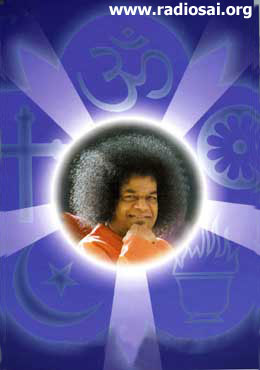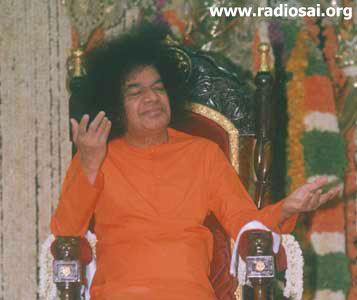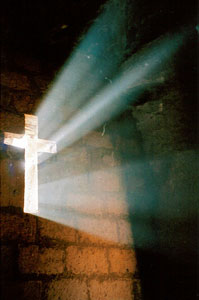THE MANTRAS OF MANTRAPUSHPAM – MULTIFAITH AND MULTIDIMENSIONAL
Om Ganeshaya Namaha | Saraswatyai Namaha | Sri Gurubhyo Namaha | Harihi Om |
Swami continues to emphasize the need for all the people across the world to learn the Vedas and apply their principles to life. He has reiterated that the Vedas are meant for everyone irrespective of whatever caste, creed, and community they may belong to. These statements trigger questions in the rational mind such as; - why does the Lord reincarnate to propagate the awareness and practical implementation of the Vedas? - how do the Vedic Hymns transcend the commonly perceived notion of their association to Hinduism and also be applicable to all other religions? This article is a humble attempt to contemplate on these questions and the insightful revelations that were conceived with Bhagawan’s Divine inspiration and grace. A general belief exists that Vedas are pertinent to the Hindu Religion since they were conceived in the language Sanskrit or Samskritam (in correct pronunciation). “When I expressed my inability to understand and chant Vedas as I do not know this language, Bhagawan chided me (in a dream) and mentioned that Samskritam is not a language and the meaning of the hymns is understood only by the depth of one’s own contemplation and practice,” says Sekhar Boddupalli, a Sai devotee from San Jose, USA and then goes on to explain how Bhagawan beautifully unraveled the universal message of the Vedas. He continues, |  |
“He unfolded a deeper and significant meaning for Samskritam: Kritam means ‘to do’ and Samyak meaning ‘in unity’. Samskritam is hence not a language; it is an awareness of the self revealed by practice with the unity of thought, word, and deed. Sruthi (intent and active listening) and Smruthi (active practice) thus became the basis of Veda Dharma (a way of life) and its propagation for time eternal.
 | VEDA contains four letters that signify the most important aspects of practical spiritual life: Values, Educare, Devotion, and Awareness. These four represent the quintessential Vedic message. Unvarying practice of the Human Values with a constant quest to Know the Self (Educare), and endless adoration of the all pervading Supreme Lord (Devotion or Bhakti) leads to constant integrated Awareness (Prajnanam). Interestingly, switching the letter V and D in VEDA makes it DEVA (meaning God in Sanskrit). Hence, VEDA and DEVA are the reflections of each other; DEVA the primary focus in a religious context and VEDA, a primary focus in a spiritual context, both leading to the same target of Self-Realization. Veda Mantras are beyond the perceptual plane of imagination. Abundant with symbolic and cryptic messages they unravel the interconnection of various aspects of creation to the supreme consciousness. The Mantrapushpam is a popular Vedic Hymn that declares the truth of creation. The chant repeatedly uses the words; Apaha, Pushpam, and Veda, as follows: |
Yopam Push pam Veda | Pushpavan Prajavan Pasuman Bhavati | Chandramaava Apam Pushpam |
Puspavan Prajavan Pasuman Bhavati | Ya Evam Veda | Yopamayatanam Veda | Ayatanavan Bhavati |
To listen to the above few lines of Mantrapushpam, click here [524 KB] |
The above hymn, from a literal standpoint, would mean that the one who understands the flowers (Pushpa) of waters (Apaha) and its relationship to the moon (Chandra) will reach the highest abode. According to Bhagawan Baba, Apaha (the waters of Life) is Love. Contemplating on the Mantrapushpam with Love substituted for Apaha unfolds a deeper and significant meaning: the one who understands the inner significance (Pushpa) of Love (Apaha) and its relationship to the mind (Chandra) will reach the highest abode. This mantra points the way beyond the confines of religion to universal human experience which the remainder of this article will expand upon.
Mantrapushpam’s Relationship to World Religions
The Mantrapushpam elucidates several aspects of creation which are the basis for several religious faiths. In fact, this article will show you how Mantrapushpam relates to all the religions represented in the Sarvadharma Symbol, which depicts the essence of Bhagavan’s Universal Love. We first look at the religion founded by Zoroastra.
Zoroastrianism
The second stanza of Mantrapushpam says -
Agnirva Apamaayatanam | Ayatanavaan Bhavati |Yo Agner Ayatanam Veda |
Ayatanavaan Bhavati | Apova Agner Ayatanam | Ayatanavaan Bhavati |
To listen to the above few lines of Mantrapushpam, click here [387 KB] |
This verse means the one who understands the significance of the sacrificial fire reaches the highest abode. ‘Agni’ means the fire. The fundamental basis of Zoroastrianism is the sacrificial fire.
Bhagavan tells us that the spiritual meaning of the sacred fire of Zoroastrianism is: ‘Offer all bitterness in the sacred fire and emerge grand, great, and godly’. Here is a sacred chant from the Zoroastrian scriptures -
mazdâ at môye vahishtâ sravâoschâ shodhanâchâ vavochâ tâ-tû vohû manandahâ
ashâchâ ishuudem ratûtô xshmâkâ xshathrâ ahurâ fershêm vasnâ haishyêm dâo aham.
To listen to the above lines of a Zoroastrian chant, click here [615 KB] |
Which means:
"And in response to my request in praises,
Wise One, tell me now the best words and deeds through good mind.
Make life truly renovated with Your sovereignty as You wish. "
Next, we have three lines following the second stanza of Mantrapushpam which are repeated many times in the hymn -
Ya Evam Veda | Yopamayatanam Veda | Ayatanavan Bhavati |
To listen to the above few lines of Mantrapushpam, click here [169 KB] |
Which means: “This is all that needs to be known. The one who is illumined by Love attains the highest abode.”
Christianity
Now we present the fourth stanza of Mantrapushpam, which can be taken to relate to Christianity in the following way:
Asouvaitapann Apamaayatanam | Ayatanavaan Bhavati | Yo(a)mushyatapata Ayatanam Veda |
Ayatanavaan Bhavati | Apovaa Amushayatapata Ayatanam | Ayatanavaan Bhavati |
To listen to the above few lines of Mantrapushpam, click here [403 KB] |
“Asouvaitapannaha” means the scorching sun. The Cross is symbolic of the pain and suffering of the scorching sun. Annihilation of the ego and the body consciousness on the cross is the essence of Christianity. The Love of Jesus for his fellow beings aids us in conquering body consciousness. This verse means the one who understands the interconnection between Love and the ‘Annihilation of the Ego’ reaches the supreme abode. Bhagavan tells us that the spiritual meaning of the cross is: ‘Cut the “I” feeling clean across and let your ego die on the cross to endow on you eternity.’ |  |
Here are two sublime hymns from the Christian tradition -
Kyrie Eleison Kyrie Eleison |Christe Eleison Christe Eleisonm | Kyrie Eleison Kyrie Eleison |
Which means, "Lord have mercy on us. Christ have mercy on us."
To listen to the above few lines of this Christian hymn, click here [1529 KB] |
And the second hymn:
Sing Hallelujah to Our Lord, Sing Hallelujah to Our Lord,
Sing Hallelujah, Sing Hallelujah, Sing Hallelujah to Our Lord
Sing Hallelujah, Sing Hallelujah, Sing Hallelujah to Our Lord
To listen to the above few lines of this second Christian hymn, click here [1262 KB] |
Again, the common refrain of Mantrapushpam -
Ya Evam Veda | Yopamayatanam Veda | Ayatanavan Bhavati |
To listen to the above lines of Mantrapushpam, click here [169 KB] |
"This is all that needs to be known. The one who is illumined by Love attains the highest abode."
Islam
The next stanza in Mantrapushpam, can be interpreted to relate to the religion of Islam. It states the following-
Chandramava Apamaayatanam | Ayatanavaan Bhavati | YasChandramasa Ayatanam Veda |
Ayatanavaan Bhavati | Apovai Chandramasa Ayatanam | Ayatanavaan Bhavati |
To listen to the above few lines of Mantrapushpam, click here [382 KB] |
 | “Chandra” means the moon. The changes of the moon are interconnected to vagaries of the mind. Fixing the mind that is filled with Love on the supreme Lord captures the spirit of Islam. Thus this verse means the one who understands the connection between the mind of fixed faith and Love reaches the highest abode. Bhagavan has given us the meaning of the crescent and moon symbol of Islam as: ‘Be like the star which never wavers from the crescent but is steady in fixed faith.’ |
And here are very elevating chants from the Koran -
BismiAllahi rrahmani rraheem | Qulahuwa Allahu ahad | Allahu ssamad | Lam yallid |
Balam yullad | Lam yaku llahu | Kufuwan ahad
To listen to the above lines of this Muslim chant, click here [383 KB] |
Which means: "In the Name of Allah, the Caring and Kind. Tell everyone: 'He is One God; Allah, Who is forever. He doesn't have children and He was never born, and there is nothing the same as Him."
Followed by this beautiful song:
Let My Heart Reflect Thy Light Lord
As the Moon Reflects the Light of the Sun In Love Always In Love
Hu Allah Allah Hu Allah Hu Allah Allah Hu
To listen to the above lines of this Muslim song, click here [1820 KB] |
And again the common refrain of Mantrapushpam -
Ya Evam Veda | Yopamayatanam Veda | Ayatanavan Bhavati |
To listen to the above few lines of Mantrapushpam, click here [169 KB] |
"This is all that needs to be known. The one who is illumined by Love attains the highest abode. "
Judaism
The subsequent stanza in Mantrapushpam can be understood to relate to the Jewish faith. It says -
Nakshatraniva Apamaayatanam | Ayatanavaan Bhavati | Yo Nakshatranam Ayatanam Veda |
Ayatanavaan Bhavati | Apovai Nakshatranaam Ayatanam | Ayatanavaan Bhavati |
To listen to the above few lines of Mantrapushpam, click here [409 KB] |
“Nakshatram” means star. The Star is symbolic of the all pervading consciousness and the soul of Judaism. Thus this verse means the one who recognizes the grandeur of the omniscient, omnipresent and omnipotent Loving Lord reaches the highest abode. Bhagavan tells us that the meaning of the Jewish star is: ‘Trust in God who rules over all six directions (east, west, north, south, up & down) symbolized by the six points of the star.’ |  |
Here is a chant extolling the Lord in Hebrew -
Sh'ma Yis-ra-eil, A-do-nai E-lo-hei-nu,
A-do-nai E-chad.
Ba-ruch sheim k'vod
mal-chu-to l'o-lam va-ed
A-do-nai E-chad.
Ba-ruch sheim k'vod
mal-chu-to l'o-lam va-ed
Hear, Israel, the Lord is our God,
the Lord is One.
Blessed be the Name of
His glorious kingdom for ever and ever
the Lord is One.
Blessed be the Name of
His glorious kingdom for ever and ever
I’v du Hashem B'simcha (4x)
Come and serve the Holy One with joy (4x)
Yi dy da dy dy Yi dy da dy dy dy | Yi dy da dy dy Yi dy dy
Yi dy da dy dy Yi dy da dy dy dy | Yi da dy dy dy dy dy
Come and serve the Holy One with joy (4x)
Yi dy da dy dy Yi dy da dy dy dy | Yi dy da dy dy Yi dy dy
Yi dy da dy dy Yi dy da dy dy dy | Yi da dy dy dy dy dy
To listen to the above few lines of this Hebrew chant, click here [169 KB] |
The eternal message of Mantrapushpam again -
Ya Evam Veda | Yopamayatanam Veda | Ayatanavan Bhavati |
To listen to the above few lines of Mantrapushpam, click here [169 KB] |
"This is all that needs to be known. The one who is illumined by Love attains the highest abode. "
Buddhism
Now we look at the last stanza of Mantrapushpam, which can be taken to concern the Buddhist religion. It is as follows:
Samvatsarova Apamaayatanam | Ayatanavaan Bhavati | Yah Samvatsarasya Ayatanam Veda |
Ayatanavaan Bhavati | Apovai Samvatsarasyaya Ayatanam | Ayatanavaan Bhavati |
To listen to the above few lines of Mantrapushpam, click here [388 KB] |
 | Samvatara” (Year) represents time. The Buddhist wheel is symbolic of the Dharma which is related to the time of cause and consequence. Love in action is Dharma which is beyond time. So this verse means the one who understands the interrelationship between Love and Time (Action) attains the highest abode. Bhagavan has given us the spiritual meaning of the Buddhist wheel as follows: ‘Remember the wheel of cause and consequence and the wheel of dharma that rights them all. |
And here is the prayer of the Three Refuges which all Buddhists chant regularly -
Buddham Saranam Gacchâmi.
Dhammam Saranam Gacchâmi.
Sangham Saranam Gacchâmi
To listen to the above few lines of this Buddhist Chant, click here [388 KB] |
Which means:
"I go to the Buddha as my refuge. I go to the Dhamma - His Doctrine, as my refuge. I go to the Sangha - His Holy Order, as my Refuge."
And now, one of the most sacred chants of Buddhism -
Om Mane Padme Hum
To listen to the above Buddhist prayer, click here [388 KB] |
Which means:
“Behold, the Jewel in the Lotus.”
The eternal message of Mantrapushpam follows again -
Ya Evam Veda | Yopamayatanam Veda | Ayatanavan Bhavati |
To listen to the above few lines of Mantrapushpam, click here [169 KB] |
"This is all that needs to be known. The one who is illumined by Love attains the highest abode. "
Hinduism
The last three lines of Mantrapushpam can be related to Hinduism which say–
Ya Evam Veda | Yoapsunavam Pratishithitam Veda | Pratyevatishtathi
To listen to the above few lines of Mantrapushpam, click here [176 KB] |
“This is all there is to know. The one who knows this is stable like a boat on the ocean of Love. He will be able to know the self that Is all there is to know.” The sound of creation and beginning of knowledge is ‘Om’. And Bhagawan says, “Listen to the primeval Pranava resounding in your heart as well as in the heart of the Universe.” It is said in the Vedas Ekam Sath Vipra Bahudha Vadanthi which means “The Truth is One and the Wise Call it by Many Names.” |  |
What we can understand in this thought-provoking article, which spans the centuries and synthesizes centuries of religious ideas, is that the various faiths express the same immortal message of the ‘love and righteousness’ of the Lord in diverse ways through culturally specific traditions. The message of the more recent religions is in no way different to the most ancient of scriptures, the Vedas. And Swami, the great synthesizer of the ancient and modern spiritual paths is showing us that truly “There is only one religion and that is the religion of love.”
“Om Shanthi Shanthi Shanthihi!”
Let there be Peace, Peace, Peace.
– Heart2Heart Team






















No hay comentarios :
Publicar un comentario